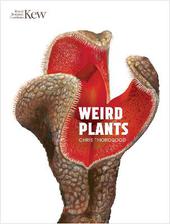
|
Weird Plants
Hardback
Main Details
| Title |
Weird Plants
|
| Authors and Contributors |
By (author) Chris Thorogood
|
| Physical Properties |
| Format:Hardback | | Pages:160 | | Dimensions(mm): Height 246,Width 189 |
|
| Category/Genre | Popular science
Trees, wildflowers and plants |
|---|
| ISBN/Barcode |
9781842466629
|
| Classifications | Dewey:583.887 |
|---|
| Audience | |
|---|
| Illustrations |
150 Halftones, color
|
|
Publishing Details |
| Publisher |
Royal Botanic Gardens
|
| Imprint |
Kew Publishing
|
| Publication Date |
24 September 2018 |
| Publication Country |
United Kingdom
|
Description
For the first time, this extraordinary compilation showcases weird, mysterious and bizarre plants from around the world. Plants trick, kill, steal and kidnap, and this unique book explores a fascinating world in which plants have turned the tables on animals. Author Chris Thorogood showcases these plant behaviours, the interrelationships among plants, the interdependencies between plants and animals, and the intrigue of plant evolution. All types of weird and sinister are featured in this book, from carnivorous plants that drug, drown and consume unsuspecting insect prey; giant pitcher plants that have evolved toilets for tree shrews; flowers that mimic rotting flesh to attract pollinating flies, and orchids that duplicitously look, feel and even smell like a female insect to bamboozle sex-crazed male bees.
Author Biography
Chris Thorogood is a botanist at the University of Oxford. He studied parasitic plant biology for his PhD at the University of Bristol where he then worked as a postdoctoral researcher. He currently studies the flora of the western Mediterranean basin and has a particular interest in parasitic plant speciation. He is the author of Field Guide to the Wild Flowers of the Western Mediterranean (Kew Publishing, 2016) which was shortlisted for the Garden Media Guild award in 2016, and co-author of Field Guide to the Wild Flowers of the Algarve (Kew Publishing, 2014).
Reviews"this weird and wonderful assortment of plants lovingly captured in Thorogood's oil paintings is far more unusual than any science fiction offering. Some are beautiful, some are macabre, but all demonstrate the incredible strategies that plants need to survive."-- "Saga Magazine" "It is both beautiful and easy to read, and serves as a stepping stone to further botanical investigation ... This is a book to inspire any reader and one that would be welcomed as a gift."-- "The Garden" "This finely illustrated book is intended to draw attention to the range of plants that might be less than pleasant to observe or even to grow, but which nonetheless display fascinating evolutionary adaptation. . . . Offering insight into important biological processes, many of these plants grow in vulnerable habitats and so are worthy of wider attention."-- "The English Garden" "Thorogood paints a full picture of the plants that have often been overlooked and dismissed as simply 'weird' looking, and draws us into the reasons behind their strange and perhaps quite frightening appearance. This isn't a book about pretty wallflowers who sit on the sidelines waiting to be attended to. These are rude plants. They've got backbone. The book opens us up to a world where plants are seen in a new light. Where we have new insight into their true colors for the first time."-- "Cent" "[Thorogood] has been making a name for himself as the kind of botanist that can engage nearly anyone in plants . . . His latest book, Weird Plants, is a case in point. Lavishly illustrated by Thorogood (who loves depicting botanical oddities as much as he does finding them), the book offers an intriguing and accessible insight into plants such as rafflesia, hydnora and welwitschia, which continue to fascinate plant biologists to this day."-- "The Daily Telegraph" "A boldly illustrated and showy collection of plant marvels such as this can be a very effective way to engage readers of all ages. It also serves as an excellent reminder of why more experienced botanists might have gotten interested in the field. Every reader will have to engage the question: What makes something 'weird'? Perhaps it simply captures the imagination or maybe it deeply stirs that fundamental mystery in our soul. Either way, while happily lost in the world of Weird Plants, the reader is allowed to anthropomorphize wildly--to image a constellation of plant motives and personalities battling it out for survival."-- "Economic Botany"
|